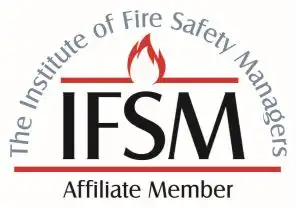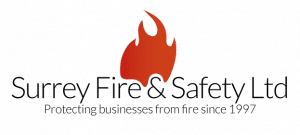Fire Compartmentation Surveys and Installation
Ensure your building is safe, compliant, and protected with expert fire compartmentation services from Surrey Fire & Safety. Fire compartments are a core part of any fire safety strategy, designed to prevent the spread of fire and smoke, protect escape routes, and safeguard high-risk or high-value areas.
We specialise in designing, inspecting, installing, and maintaining fire-resistant compartmentation systems for residential, commercial, and industrial properties.
Every wall, floor, door, and barrier is tested and certified to meet Building Regulations Part B and BS 9999 standards, giving you regulatory compliance and peace of mind.
Whether you manage a property, housing association, or business premises, Surrey Fire & Safety delivers practical solutions and long-term protection.
Compartmentation is a crucial part of fire safety – just like fire extinguishers.
Get in TouchWhat Is Fire Compartmentation
Fire compartmentation divides a building into fire-resistant zones, known as compartments. These prevent fire and smoke from spreading rapidly through open spaces, giving occupants time to escape safely and emergency services time to respond.
It’s a part of the passive fire protection solutions and strategies. They work together with active measures, like wireless fire alarm systems.
The Two Main Objectives:
- Life safety – Protecting escape routes such as stairwells, corridors, lobbies, and refuge areas so occupants can evacuate before fire and smoke compromise those paths.
- Property protection – Containing fire to its area of origin, particularly in high-risk zones such as kitchens, plant rooms, IT suites, or storage areas.
Each compartment is defined by fire-resisting walls, floors, doors, ceilings, and service penetrations. These elements are engineered to withstand fire for a specified duration (typically 30, 60, 90 or 120 minutes), depending on the building type and usage.
When properly maintained, fire compartmentation acts as an invisible safety net — constantly on guard, without requiring any human intervention during an emergency.
Our Fire Compartmentation Services
Effective fire compartmentation is more than just walls and doors. Each element of a system plays a vital role in slowing fire spread, and – in consequence – all of the risks that follow.
At Surrey Fire & Safety, we use a comprehensive approach, combining regulatory expertise, hands-on experience, and practical solutions to ensure your building is fully protected – whatever it is.
From identifying weak points in existing structures to installing high-performance fire stopping solutions, our team provides end-to-end support every step of the way. We offer:
Compartmentation Surveys and Reports
Identifying breaches, poor workmanship, or non-compliance. Each survey includes: photographic evidence of issues, prioritised remedial recommendations and guidance for regulatory compliance.
Fire Stopping and Sealing Works
Reinstating fire integrity around service penetrations such as pipes, cables, ducts, and joints to maintain compartment boundaries and prevent fire spread.
Wall and Floor Upgrades
Repairing or upgrading partitions, ceilings, and cavity barriers to restore fire resistance and prevent the spread of fire between compartments.
Door and Ventilation Assessments
Inspecting fire doors to verify they perform as intended within the compartmentation design & conducting repairs and replacements.
Ongoing Maintenance and Re-inspection
Regular reviews to support compliance with the Fire Safety (England) Regulations 2022 and maintain long-term protection
Contact our friendly team of experts today, and make sure your building is safe and compliant!
Contact UsKey Components of a Fire Compartmentation System
Fire compartmentation is a complex network of passive fire protection measures that work together. These typically include:
- Fire Doors – Correctly fitted, certified fire doors prevent smoke and flame from spreading between compartments. They must never be propped open and require regular inspection.
- Fire-Stopping – Sealing service penetrations (pipes, cables, ducts) with tested fire-resistant materials prevents unseen breaches through walls, floors, and ceilings.
- Cavity Barriers – Installed within wall or roof voids to block the movement of smoke and flame through concealed spaces.
- Fire & Smoke Dampers – Automatic devices within ductwork that close in response to rising temperatures or smoke detection, maintaining compartment integrity.
- Construction Materials – The fabric of the building (timber, concrete, steel, brick) dictates the appropriate fire protection approach and materials used.
Even a single weakness in one of these elements — a poorly sealed service gap or damaged fire door — can allow fire and smoke to spread rapidly through an entire building.
Fire Compartmentation Surveys
The goal of a fire compartmentation survey is to assess how well your building’s existing fire barriers perform — and whether they still meet current safety and compliance standards.
Over time, even small changes like new cabling, ceiling repairs, or refurbishments can compromise fire resistance.
A professional survey identifies these weaknesses, helping you maintain a safe, legally compliant environment.
Similarly to different types of fire risk assessment, there are essentially two possible ways to carry out the survey:
| Type | What It Involves |
| Non-Intrusive (Visual) Survey | Surface-level inspection of visible walls, floors, ceilings, doors, and service penetrations. Identifies obvious breaches, poor installations, or missing fire-stopping. Common for routine compliance checks and newer buildings. |
| Intrusive (Destructive) Survey | Detailed inspection requiring openings in walls, floors, ceilings, or façades to check hidden cavities, fire-stopping, and construction integrity. Used for older buildings or when visual surveys indicate potential hidden issues. |
Surveys typically include:
- Reviewing the building’s fire strategy or fire plan drawings
- Inspecting roof voids, floors, walls, basements, shafts, and risers
- Checking passive and active elements, including fire doors, dampers, and shutters
Why Choose Surrey Fire & Safety?
- Independent fire safety experts with extensive experience in compartmentation
- Fully compliant with Building Regulations Part B and BS 9999
- Clear, actionable reports with priority ratings for remedial work
- Trusted by property managers, housing associations, and contractors across the South East
Book a Fire Compartmentation Survey
Ensure your building’s fire compartments are fully compliant and effective.
Contact Surrey Fire & Safety today to book a professional compartmentation survey or discuss remedial works with our team.
Choose safety. Choose Surrey Fire.
Book a Fire Compartmentation SurveyFAQ – Fire Compartmentation
Is compartmentation a structural fire precaution?
Yes. Fire compartmentation is a structural passive fire protection measure. It uses fire-resistant walls, floors, ceilings, doors, and barriers to divide a building into compartments, preventing fire and smoke from spreading. This gives occupants time to escape safely and limits property damage.
Is it a legal requirement?
For most commercial, multi-occupancy, and certain residential buildings, yes. Fire compartmentation is required under Building Regulations Part B and must comply with BS 9999 guidance. It’s also an integral part of compliance with the Regulatory Reform (Fire Safety) Order 2005, which sets out fire safety duties for building owners and managers in England and Wales.
What is a fire compartmentation survey?
A fire compartmentation survey is a detailed inspection to check that a building’s compartments are compliant and fully functional. The survey identifies breaches, faulty installations, or gaps in fire-stopping.
What is the British Standard for compartmentation?
BS 9999:2017 provides guidance for fire safety in the design, management, and use of buildings. It covers:
- Fire-resisting materials and construction methods
- Compartmentation strategies
- Performance standards for doors, walls, and other barriers
- Fire safety management, including maintenance and inspection schedules
What are common breaches in fire compartmentation?
Common issues include:
- Gaps around pipes, cables, and ducts
- Poorly fitted or damaged fire doors
- Incomplete or missing fire-stopping in walls, floors, or ceilings
- Alterations or repairs that compromise integrity
Even small breaches can allow fire or smoke to spread between compartments, reducing the effectiveness of the safety strategy.
What is the difference between fire separation and compartmentation?
Fire separation refers to individual fire-resisting elements such as a wall, door, or floor. Compartmentation is the overall system that combines these elements to divide the building into safe, fire-resistant zones. Compartmentation is the holistic approach to controlling fire spread.
What are the requirements for fire compartmentation?
Key requirements include:
- Compliance with Building Regulations Part B and BS 9999
- Effective fire-stopping and cavity barriers
- Certified fire doors, walls, floors, and ceilings
- Regular inspections, testing, and maintenance to ensure integrity
Arrange a callback







